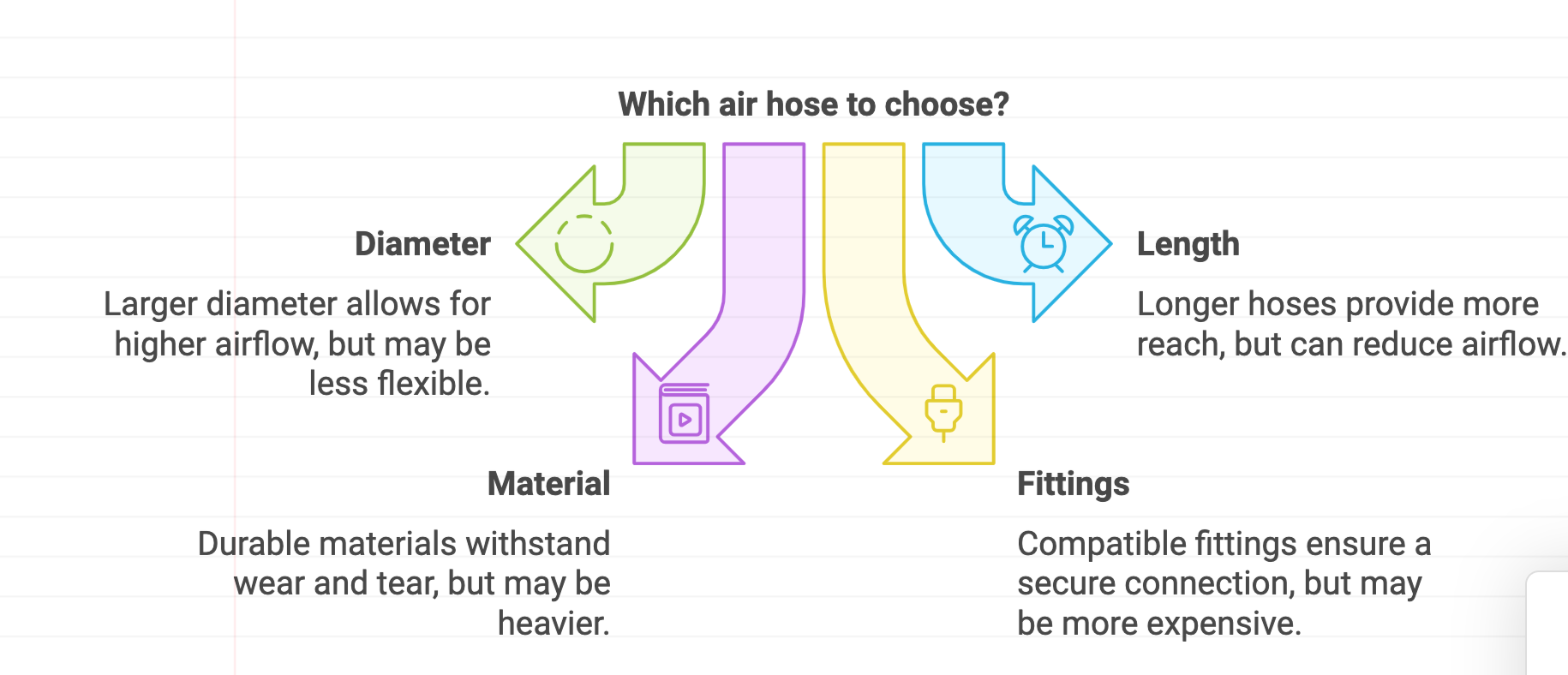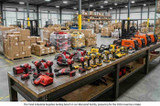Top 10 Must-Have Pneumatic Tools for Every Workshop in 2025
In the ever-evolving world of workshop technology, pneumatic tools continue to stand out for their power, efficiency, and reliability. As we approach 2025, these air-powered marvels are becoming increasingly essential for both professional mechanics and DIY enthusiasts. Whether you're setting up a new workshop or upgrading your existing toolkit, here's our comprehensive guide to the top 10 must-have pneumatic tools that will revolutionize your work in 2025.
1. Air Compressor: The Heart of Your Pneumatic System
No pneumatic tool setup is complete without a high-quality air compressor. In 2025, we're seeing more efficient and quieter models that cater to various workshop sizes and needs.
Key Features to Look for:
- Capacity: 20-30 gallon tank for most workshop applications
- Output: 4-5 CFM at 90 PSI for versatility
- Noise Level: Look for models with noise reduction technology
- Portability: Consider wheeled options for easy movement
Top Pick: The Tend Industrial Supplies Ultra-Quiet 30-Gallon Compressor offers an ideal balance of power and noise reduction, perfect for residential workshops.
Key Features:
- Adequate CFM output for your tools (typically 4-30 CFM)
- Appropriate tank size (10-80 gallons)
- Oil-lubricated or oil-free design
Applications:
- Powering all pneumatic tools
- Inflating tires
- Cleaning with compressed air
Safety Tip: Regularly drain the tank to prevent moisture buildup.
Noise Level: Varies widely, from 60 dB (quiet models) to 90+ dB (larger units)
2. Air Impact Wrench: Power Meets Precision
Impact wrenches remain a staple in automotive work and heavy-duty applications. The 2025 models offer improved torque control and ergonomic designs.
Key Benefits:
- High torque output for stubborn bolts and nuts
- Faster than manual wrenches
- Reduces user fatigue
Recommended Model: Shinano 3/8 Square Drive Pneumatic Air Impact Wrench from Tend Industrial Supplies, known for its durability and precision.
Key Features:
- High torque output (typically 500-1200 ft-lbs)
- Variable speed control
- Compact design for tight spaces
Applications:
- Changing tires and removing lug nuts
- Working on suspension systems
- Loosening seized bolts in automotive repair
Safety Tip: Always use impact-rated sockets to prevent shattering.
Noise Level: Approximately 90-100 dB
3. Air Drill: Versatility in Boring
Air drills continue to outperform their electric counterparts in terms of power-to-weight ratio and durability.
Advantages:
- Cooler operation for extended use
- More compact design for tight spaces
- Consistent power output
Featured Product: 1/2 Shinano Reversible Pneumatic Drill 800 RPM SI-5305-8A, ideal for steel drilling and automotive work.
Key Features:
- High RPM (usually 1800-2600 RPM)
- Reversible direction
- Chuck sizes from 3/8" to 1/2"
Applications:
- Drilling holes in metal, wood, or plastic
- Reaming existing holes
- Light grinding with appropriate attachments
Safety Tip: Use clamps to secure workpieces and wear eye protection.
Noise Level: Approximately 90-100 dB
4. Air Sander: Smooth Operator
For achieving flawless finishes in woodworking and auto body repair, an air sander is indispensable.
Types to Consider:
- Orbital sanders for general smoothing
- Belt sanders for large surface areas
- Detail sanders for intricate work
Top Choice: Shinano Mini Dual Action Sander SI-2107A, offering precision and efficiency in a compact design.
Key Features:
- Orbital or linear sanding motion
- Variable speed control
- Dust collection system
Applications:
- Smoothing wood surfaces before finishing
- Prepping metal for paint application
- Removing rust or old paint
Safety Tip: Always use in well-ventilated areas and wear a dust mask.
Noise Level: Around 80-90 dB
5. Air Nailer/Stapler: Fastening Made Easy
In 2025, air nailers and staplers are more versatile than ever, accommodating a wide range of fasteners for various applications.
Applications:
- Woodworking and carpentry
- Upholstery
- Roofing and siding installation
Recommended: Universal Tool Pneumatic Nailer, compatible with multiple nail sizes for diverse projects.
Key Features:
- Sequential and bump firing modes
- Depth adjustment
- Easy-to-load magazine
Applications:
- Framing and construction work
- Installing trim and molding
- Upholstery and woodworking projects
Safety Tip: Never point the tool at yourself or others, even when not in use.
Noise Level: Approximately 70-80 dB
6. Air Spray Gun: Perfect Finish Every Time
For painting and coating applications, nothing beats the consistency and coverage of an air spray gun.
Key Features:
- Adjustable spray patterns
- Easy-clean nozzles
- Compatibility with various paint viscosities
Best Pick: FPX Air Tools HVLP Gravity Feed Spray Gun Kit FPX-535K for professional-grade finishes.
Key Features:
- Adjustable spray patterns
- Precise fluid control
- Easy-to-clean design
Applications:
- Painting vehicles or furniture
- Applying stains or varnishes
- Spraying texture on walls or ceilings
Safety Tip: Always use in a well-ventilated area and wear appropriate respiratory protection.
Noise Level: Around 70-80 dB
7. Air Ratchet: Tight Spaces, No Problem
When working in confined spaces, an air ratchet is your best friend, offering power and maneuverability.
Benefits:
- Faster than manual ratchets
- Reduces hand fatigue
- Ideal for automotive and machinery maintenance
Top Model: 3/8 Flex-Head Air Ratchet Aircat 811, known for its flexibility and precision.
Key Features:
- Compact head for tight spaces
- Typically 30-60 ft-lbs of torque
- Lightweight design for extended use
Applications:
- Removing and installing engine components
- Working in confined spaces under vehicles
- Quick assembly of furniture or equipment
Safety Tip: Keep your fingers clear of moving parts and use appropriate PPE.
Noise Level: Around 85-95 dB
8. Air Hammer: Break It Down
For demolition work, chiseling, and heavy-duty material removal, an air hammer is essential.
Applications:
- Automotive body work
- Construction and renovation
- Sculptural work
Recommended: Pistol Air Hammer Universal Tool UT8645-1, offering robust performance for various tasks.
9. Air Grinder: Precision Grinding and Cutting
Versatile and powerful, air grinders are crucial for metalworking, welding prep, and surface finishing.
Types:
- Die grinders for precision work
- Angle grinders for larger surfaces
- Cut-off tools for metal cutting
Featured Product: SP-180 Heavy Duty Pneumatic 7-inch Air Angle Grinder, suitable for welding, woodworking, and automotive detailing.
Key Features:
- High RPM (typically 10,000-25,000 RPM)
- Various wheel sizes available (usually 2"-7")
- Safety guard and ergonomic grip
Applications:
- Cutting metal pipes or rods
- Smoothing welds
- Sharpening tools
Safety Tip: Always use the appropriate wheel for the material and task.
Noise Level: Around 90-100 dB
10. Air Blow Gun: Clean and Clear
Often overlooked but incredibly useful, an air blow gun is perfect for cleaning workspaces and machinery.
Uses:
- Removing debris from hard-to-reach areas
- Drying surfaces quickly
- Clearing dust from sensitive equipment
Top Choice: FPX Air Blow Gun with adjustable nozzle for versatile cleaning applications.
Key Features:
- Adjustable air flow
- Lightweight design
- OSHA-compliant nozzle
Applications:
- Cleaning dust and debris from workspaces
- Drying parts after washing
- Clearing blockages in machinery
Safety Tip: Never use compressed air to clean clothing or skin.
Noise Level: Approximately 80-90 dB
Others
Air Chisel
Key Features:
- Variable speed control
- Quick-change chisel retention
- Vibration-reducing design
Applications:
- Cutting sheet metal
- Removing stuck bolts or rivets
- Breaking up concrete or tile
Safety Tip: Use a tool rest to minimize hand fatigue and improve accuracy.
Noise Level: Approximately 100-110 dB
Comparison of Top 10 Pneumatic Tools
| Tool Type | Power Output | Noise Level | Versatility | Maintenance Needs |
| Air Compressor | High | Medium-High | High | Medium |
| Impact Wrench | Very High | High | Medium | Low |
| Air Drill | High | Medium | High | Low |
| Air Sander | Medium | Medium | High | Medium |
| Nailer/Stapler | Medium | Low | High | Low |
| Spray Gun | Low | Low | Medium | High |
| Air Ratchet | Medium | Low | Medium | Low |
| Air Hammer | Very High | Very High | Medium | Medium |
| Air Grinder | High | High | High | Medium |
| Air Blow Gun | Low | Medium | High | Very Low |
Air Hose Selection
Choosing the right air hose is crucial for the efficient operation of your pneumatic tools:
- Diameter: Most tools require a 1/4" or 3/8" inner diameter hose.
- Length: Keep hoses as short as practical to minimize pressure loss.
- Material: Options include rubber (durable, flexible), PVC (lightweight, less flexible), and hybrid (balances durability and weight).

Safety Tip: Regularly inspect hoses for cracks or damage, and ensure proper connection to prevent accidental detachment.
General Safety Considerations
- Proper Ventilation: Ensure good airflow, especially when using tools that generate dust or fumes.
- Personal Protective Equipment (PPE): Always wear safety glasses, hearing protection, and other PPE as required for each tool.
- Tool Maintenance: Regularly clean and lubricate tools according to manufacturer instructions.
- Pressure Regulation: Use the correct air pressure for each tool to ensure safe operation and optimal performance.
- Training: Familiarize yourself with each tool's operation and safety features before use.
Safety and Maintenance Tips:
- Always wear appropriate PPE, including safety glasses, hearing protection, and gloves.
- Regularly inspect air hoses and fittings for wear and damage.
- Lubricate tools according to manufacturer instructions, typically before each use.
- Drain moisture from the air compressor tank daily to prevent rust and contamination.
- Store tools in a clean, dry place to prevent corrosion and damage.
Choosing the Right Pneumatic Tools:
When selecting pneumatic tools for your 2025 workshop, consider the following factors:
- Assess Your Needs: Identify the tasks you perform most frequently.
- Evaluate Your Air Compressor: Ensure it can handle the CFM requirements of your tools.
- Quality and Durability: Invest in reputable brands known for reliability.
- Ergonomics: Choose tools that are comfortable for extended use.
- Versatility: Look for tools that can perform multiple functions.
- Budget: Balance cost with expected usage and longevity.
- Noise Levels: Consider quieter models for residential workshops.
- Future Expansion: Choose tools that can adapt to increasing demands.
FAQs: Pneumatic Tools for Workshops in 2025
Q: Are pneumatic tools more powerful than their electric counterparts?
A: Generally, yes. Pneumatic tools often deliver more power and torque for their size compared to electric tools, making them particularly effective for heavy-duty tasks.
Q: How do I maintain my pneumatic tools to ensure longevity?
A: Regular maintenance is key. Lubricate tools with air tool oil before each use, clean them after use, store in a dry place, drain moisture from the air compressor tank regularly, and replace worn parts promptly.
Q: Can I use the same air hose for all my pneumatic tools?
A: While many tools use standard fittings, it's important to check the air flow requirements (CFM) and pressure (PSI) for each tool. Some high-demand tools may require larger diameter hoses for optimal performance.
Q: Are pneumatic tools safe to use in wet conditions?
A: Pneumatic tools are generally safer than electric tools in damp environments as there's no risk of electric shock. However, always follow safety guidelines and avoid submerging tools in water.
Q: How do I choose the right size air compressor for my workshop?
A: Consider the CFM (Cubic Feet per Minute) requirements of your most demanding tools. For most workshop applications, a compressor with 20-30 gallon tank capacity and 4-5 CFM at 90 PSI is sufficient.
Q: What are the advantages of pneumatic tools over cordless tools?
A: Pneumatic tools often offer higher power-to-weight ratios, consistent performance without battery drain, and lower tool costs. However, they require an air compressor and are less portable than cordless options.
Q: How do I troubleshoot common problems with pneumatic tools?
A: For low power, check air pressure and hose connections. For air leaks, inspect O-rings and fittings. If problems persist, consult the tool's manual or a professional.
Q: Where can I find repair services for my pneumatic tools?
A: Many hardware stores offer repair services. Additionally, manufacturer-authorized service centers can provide specialized repairs and maintenance.
Q: How often should I service my pneumatic tools?
A: For heavy use, service tools every 3-6 months. For occasional use, annual servicing is usually sufficient. Always follow manufacturer recommendations.
Q: Can I use the same air compressor for all my pneumatic tools?
A: While many tools can share a compressor, ensure it provides sufficient CFM (Cubic Feet per Minute) for your most demanding tool. Some specialized tools may require a larger or more powerful compressor.
By incorporating these must-have pneumatic tools and following proper safety protocols, you'll be well-equipped to tackle a wide range of projects in your 2025 workshop. Remember to always prioritize safety and proper tool maintenance for the best results and longevity of your equipment.









